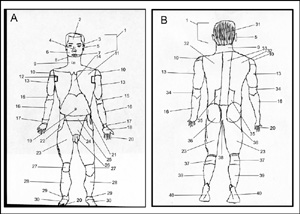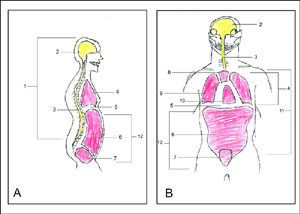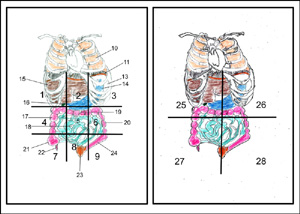Language of Anatomy Basics |
The body is often divided into two fundamental divisions, the axial Division and the appendicular division. The axial division refers to head, neck, and thorax, all which make up the body's main axis. The appendicular division consists of the limbs. The appendicular division is attached to the axial division. Within these divisions we can further describe particular areas using regional terms.
The remainder of this page will highlight the various ways in which we can describe various areas of the body, and how we can related these various areas to one another.
-O. James
© Orin James 2013 Regions of the Body
Regions of the Body
The collage on the right contains the body's anterior (A) and posterior (B) aspects.
Click on image for larger representation. Drawings by Orin James.
As mentioned in the introduction, regional terms can be used to describe the various areas of the body. Here is a list of the body's regions:
-O. James
© Orin James 2013 Regions of the Body
Regions of the Body
The collage on the right contains the body's dorsal (A) and ventral (B) cavities.
Click on image for larger representation. Drawings by Orin James.
Along with the various regions detailed above, anatomists and physiologists often reference the body's cavities. The two large categories that are further broken down into several cavities are the Dorsal and Ventral body cavities. The dorsal body cavity is responsible for protecting the organs of the nervous system. These include the brain and spinal cord. However, while both the brain and spinal cord are protected by the dorsal cavity, each organ has its own cavity. The brain is protected by the Cranial Cavity, while the spinal cord is protected by Vertebral/Spinal Cavity.
The ventral body cavity is anterior to the dorsal cavity and is responsible for encasing and protecting the visceral organs. These include the heart, lungs, digestive organs, and reproductive organs, collectively called Vicera/Viceral Organs. It too is broken down into two other cavities, namely, the Thoracic and the Abdominopelvic cavities. The thoracic and abdominopelvic cavities are separated by the diaphragm. The thoracic cavity, which is responsible for protecting the vital organs (heart, lungs) is encased in the ribs and muscles of the chest, is divided into the two lateral Plural, and central Mediastinum cavities. the pleural cavities encase and protect the lungs, while the mediastinum cavity encases the heart within another cavity called the Pericardial cavity. Lastly, the abdominopelvic cavity, as the name implies, contains the Abdominal and Pelvic cavities. The abdominal cavity encases and protects the stomach, liver, spleen, and other organs, while the pelvic cavity encases and protects the reproductive organs, urinary bladder and the rectum.
The organs mentioned above are all protected by a double layer serous membrane. The layer of the membrane that clings to the organs is referred to as the Visceral Serosa. The layer that clings to to the walls of the cavity is referred to as the Parietal Serosa. The serous membrane has a lubricating fluid called Serous Fluid for allowing organs to easily slide against the cavity walls as they move. For example as the heart contracts it expands in size as it expands it my rub against the cavity wall, but thanks to the serous fluid, friction may be minimized if not present at all.
-O. James
© Orin James 2013 Abdominopelvic Regions/Cavities
Abdominopelvic Regions/Cavities
The collage on the right contains the abdominopelvic region/cavity. The image on the left depicts one scheme used the divide the abdominopelvic region into nine separate regions, while the image on the right shows another scheme commonly used to divide the abdominopelvic region into four quadrants.
Click on image for larger representation. Drawings by Orin James.
Along with all the regions and cavities outlined above anatomists will choose further delineate the abdominopelvic region/ cavity, using one of two schemes. The first, as depicted in the left image, uses four planes to demarcate nine regions of the abdominopelvic region. Using another scheme, as depicted in the right image, anatomists will demarcate the various regions using two planes to create four quadrants.
-O. James
© Orin James 2013